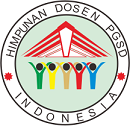EVALUASI PROGRAM EKSTRAKURIKULER CODING DI SD PANGUDI LUHUR AMBARAWA MENGGUNAKAN MODEL DISCREPANCY EVALUATION
DOI:
https://doi.org/10.24114/sejpgsd.v15i2.66274Keywords:
Evaluation, Coding Program, Extracurricular, Discrepancy Evaluation, SD Pangudi Luhur AmbarawaAbstract
This study evaluates the extracurricular coding program at SD Pangudi Luhur Ambarawa using the Discrepancy Evaluation model, to see the level of gap between the standards and objectivies that have been set and the implementation of the program, which includes five aspects: design, installation, process, product, and cost-benefit. Coding is becoming an increasingly important skill in the digital era, so it is introduced in extracurricular activities to improve understanding of programming concepts, creativity, and structured logical thinking skills. This study used quantitative and qualitative approaches woth evaluation methods. Data were collected through questionnaires, interviews, observations, and document studies with research subjects including principals, teachers, coordinators, extracurricular assistants, coding tutors, and students. The data analysis technique used was the Miles and Huberman model which includes data collection, data reduction, data display, and conclusion drawing. The evaluation results show that the extracurricular coding program has been running in accordance with predetermined standards with a very low level of gap or discrepancy in each aspect analyzed. Nevertheless, there are still some obstacles in its implementation, such as the delay of some students in completing the coding project and technical technical constraints related to facilities and infrastructure. However, the program is still considered to provide significant benefits for both students and schools in improving 21st century skills in technology. Therefore, the coding extracurricular program at SD Pangudi Luhur Ambarawa is recommended to be further developed with improved facilities and more optimal learning strategies. This study evaluates the extracurricular coding program at SD Pangudi Luhur Ambarawa using the Discrepancy Evaluation model, to see the level of gap between the standards and objectivies that have been set and the implementation of the program, which includes five aspects: design, installation, process, product, and cost-benefit. Coding is becoming an increasingly important skill in the digital era, so it is introduced in extracurricular activities to improve understanding of programming concepts, creativity, and structured logical thinking skills. This study used quantitative and qualitative approaches woth evaluation methods. Data were collected through questionnaires, interviews, observations, and document studies with research subjects including principals, teachers, coordinators, extracurricular assistants, coding tutors, and students. The data analysis technique used was the Miles and Huberman model which includes data collection, data reduction, data display, and conclusion drawing. The evaluation results show that the extracurricular coding program has been running in accordance with predetermined standards with a very low level of gap or discrepancy in each aspect analyzed. Nevertheless, there are still some obstacles in its implementation, such as the delay of some students in completing the coding project and technical technical constraints related to facilities and infrastructure. However, the program is still considered to provide significant benefits for both students and schools in improving 21st century skills in technology. Therefore, the coding extracurricular program at SD Pangudi Luhur Ambarawa is recommended to be further developed with improved facilities and more optimal learning strategies.References
Damayanti, W. R., & Dwikurnaningsih, Y. (2020). Evaluasi Program Ekstrakurikuler Di Sdn Candirejo Kabupaten Semarang. Refleksi Edukatika : Jurnal Ilmiah Kependidikan, 11(1), 59–69. https://doi.org/10.24176/re.v11i1.4772
Darmalaksana, W. (2020). Metode Penelitian Kualitatif Studi Pustaka dan Studi Lapangan. Pre-Print Digital Library UIN Sunan Gunung Djati Bandung, 1–6.
Firmansyah, B., Priawijaya Nur, A., Angellia, F., Cahya, W., & Silvanie Akbar, A. (2020). Pengenalan Coding Bagi Usia Sekolah Menggunakan Aplikasi SHINIBIK (Shinhan University dan IBI Kosgoro 1957) Bagi Murid Sekolah Dasar Negeri 11 Lenteng Agung Jakarta Selatan. Jurnal Pengabdian Teratai, 1(1), 51. https://ejournal-ibik57.id
Lady, Anisa, A. P. N., Ardiyano, B., Louis, K., Seren, & Apriyanti, V. C. (2021). Pengembangan Bahan Ajar Mata Pelajaran ICT Fokus Coding Menggunakan Program “Scratch” Tingkat SD untuk SD Kallista Batam. Prosiding National Conference for Community Service Project (NaCosPro), 3(1), 502–510. http://journal.uib.ac.id/index.php/nacospro
Muklason, A., Riksakomara, E., Mahananto, F., Djunaidy, A., Vinarti, R. A., Anggraeni, W., Nurita, R. T., Utamima, A., Fauzia, R., Theresia, L. W., Fikri, M. A., Propitadewa, H., Habibah, J. H., Prasetyo, J. D., Permatasari, S. T. I., Risnina, N. N., Tsaniyah, N. D., & Maulana, M. D. (2023). Coding for Kids: Pengenalan Pemrograman untuk Anak Sekolah Dasar sebagai Literasi Digital Baru di Industri 4.0. Sewagati, 7(3). https://doi.org/10.12962/j26139960.v7i3.506
Parid, M., & Alif, A. L. S. (2020). Pengelolaan Sarana dan Prasarana Pendidikan. Tafhim Al-’Ilmi, 11(2), 266–275. https://doi.org/10.37459/tafhim.v11i2.3755
Additional Files
Published
Issue
Section
License
Copyright (c) 2025 SCHOOL EDUCATION JOURNAL PGSD FIP UNIMED

This work is licensed under a Creative Commons Attribution-ShareAlike 4.0 International License.
Authors whose manuscripts are approved are approved as follows:
- The publication rights for all journal manuscript materials published/published on the SEJ (School Education Journal) E-Journal site are held by the editorial board with the author's knowledge (moral rights remain with the manuscript authors).
- The formal legal requirements for accessing this electronic digital journal article are subject to the terms of the Creative Commons Attribution-ShareAlike (CC BY-SA 4.0) license, which means that E-Journal SEJ (School Education Journal) has the right to store, transfer media/format, manage in the form of a database, maintain, and publish articles without asking permission from the author as long as the author's name remains as the copyright owner.
- Manuscripts published/published electronically are open access for educational, research, and library purposes.













